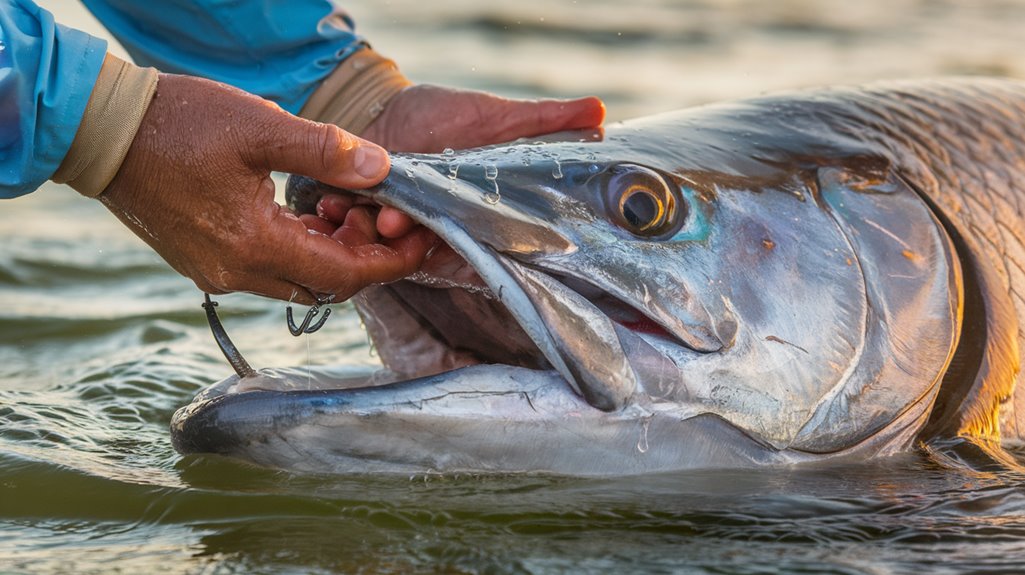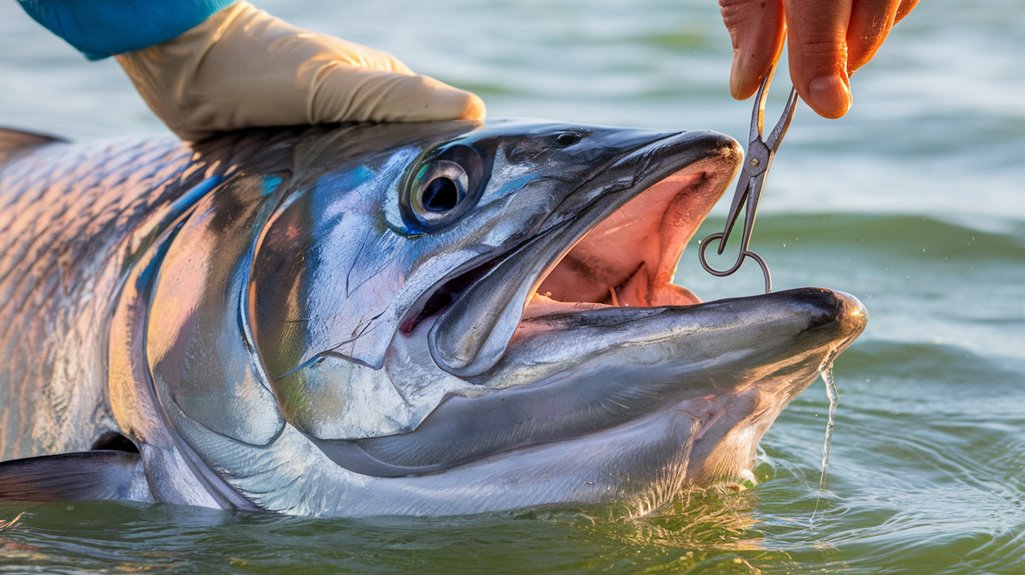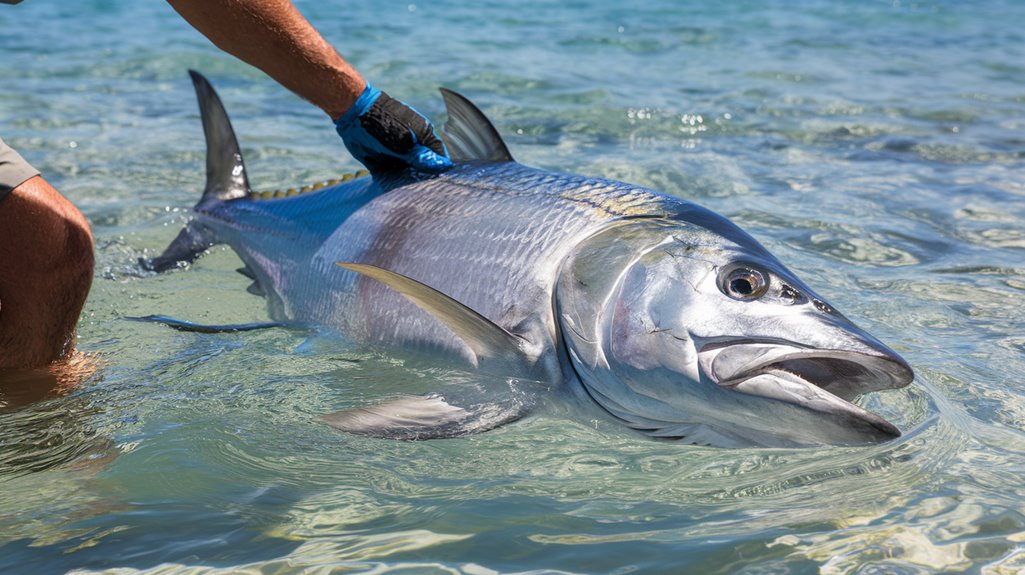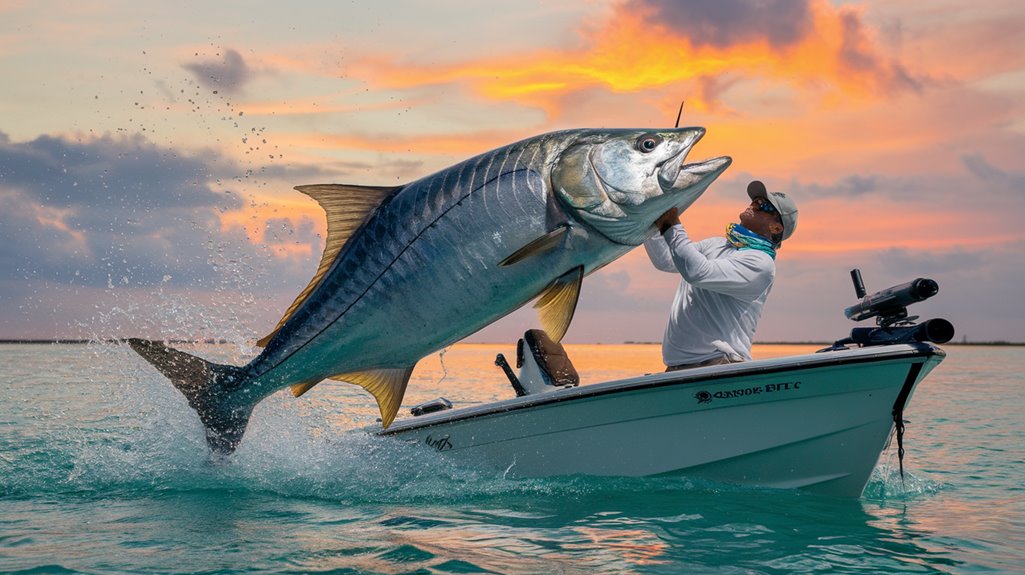You’ll find that successful tarpon conservation hinges on mastering proper catch-and-release techniques. As these magnificent gamefish face increasing pressure from recreational fishing, your approach to handling them can mean the difference between survival and mortality. Research shows that specific gear choices, fight management, and release protocols directly impact post-release survival rates. Understanding these critical factors will transform you into a more effective conservation-minded angler.
- Key Takeaways
- Essential Gear for Responsible Tarpon Fishing
- Understanding Florida's Tarpon Regulations
- Best Practices for Hook Selection and Usage
- Mastering the Fight Without Exhausting the Fish
- Proper Handling Techniques to Ensure Survival
- Boca Grande Pass Special Requirements
- Predator Awareness and Safety Measures
- Environmental Factors Affecting Release Success
- Supporting Tarpon Conservation Efforts
- Advanced Catch-and-Release Methods
- Frequently Asked Questions
- Conclusion
Key Takeaways
- Use non-stainless, barbless circle hooks and keep fight times minimal to reduce stress and injury to tarpon.
- Keep all tarpon over 40 inches in the water and limit handling time to under 15 seconds.
- Support large tarpon horizontally with wet hands and maintain water flow over gills during revival.
- Monitor water temperature closely, as temperatures above 75°F increase stress and require more careful handling.
- Cut the line close to the hook if deeply hooked, and avoid lifting tarpon from water for photographs.
Essential Gear for Responsible Tarpon Fishing

When pursuing tarpon with conservation in mind, selecting the appropriate fishing gear becomes essential for both successful angling and fish survival. You’ll need non-stainless, barbless circle hooks that minimize injury and support effective catch-and-release practices. Match your tackle to conditions by using medium to extra heavy rods with 5,000 to 10,000 series reels, maintaining 12 pounds of drag for ideal handling. A fighting belt provides vital support during extended battles, reducing stress on both you and the fish. For proper conservation practices, keep a long-handled dehooking tool readily available to minimize handling time and increase survival rates. Remember to comply with regulations by storing any illegal gear before entering restricted areas like Boca Grande Pass, ensuring sustainable fishing practices.
Understanding Florida’s Tarpon Regulations
Maneuvering Florida’s tarpon regulations requires a thorough understanding of the state’s catch-and-release mandate and specific handling protocols. You’ll need to comply with Florida Fish and Wildlife conservation measures that prioritize the species’ preservation through strict gear restrictions and handling procedures.
Key regulations you must follow:
- Keep all tarpon over 40 inches in the water unless you’re pursuing a record with your annual tarpon tag
- Limit your vessel to three fishing lines during peak season (April-June) in Boca Grande Pass
- Avoid prohibited fishing practices including snagging, snatch hooking, spearing, and using multiple hooks with natural bait
- Never use breakaway gear in Boca Grande Pass, as it’s strictly prohibited
These ethical fishing practices guarantee sustainable tarpon populations while maintaining Florida’s world-class sportfishing opportunities.
Best Practices for Hook Selection and Usage

Proper hook selection stands as the foundation of responsible tarpon fishing, building upon Florida’s conservation regulations. You’ll need to choose non-stainless, non-offset, barbless circle hooks to optimize catch-and-release success and minimize damage to these magnificent fish.
Best practices emphasize using single hook rigs, which reduce the risk of deep hooking and facilitate quick release. If a tarpon does swallow the hook, cut your line as close to the hook as possible to reduce stress on the fish. Avoid jigs with sliding weights on the shank, as they’re prohibited in certain areas like Boca Grande Pass and can lead to improper hook placement. Following these hook selection guidelines, along with using only hook and line gear, supports conservation efforts and guarantees compliance with fishing regulations.
Mastering the Fight Without Exhausting the Fish
Successfully fighting a tarpon requires a delicate balance between maintaining control and preventing fish exhaustion. Your tackle selection and fighting techniques directly impact the tarpon’s survival after release. To minimize stress and fight time while maintaining conservation principles, implement these scientifically-proven methods:
- Match your tackle to the tarpon’s size, using medium to extra-heavy rods with minimum 12-pound drag settings
- Point your rod tip toward the fish during jumps and maintain consistent tension during runs
- Utilize the rod’s backbone by pulling opposite to the tarpon’s direction, reducing fight duration
- Employ a fighting belt for improved leverage and monitor the fish’s condition throughout the fight
If you notice signs of extreme stress or loss of equilibrium, cut the line near the hook to prioritize the tarpon’s survival.
Proper Handling Techniques to Ensure Survival

You’ll need to minimize your handling time to under 15 seconds, as research shows prolonged air exposure increases post-release mortality by six times. When handling tarpon, support their body weight horizontally across the belly and head while using wet hands or gloves to protect their essential slime layer. For specimens over 40 inches, you must keep them in the water during the entire catch-and-release process, unless you’re pursuing a record catch, to maximize their survival chances.
Minimize Handling Time
When releasing tarpon, minimizing handling time is critical for their survival and long-term conservation. You’ll need to prepare thoroughly before handling the fish, ensuring all release tools are readily accessible and your camera is set for quick documentation.
- Keep tarpon exceeding 40 inches completely submerged, as large specimens experience heightened stress when removed from water
- Use wet hands when handling smaller tarpon to preserve their protective slime layer, supporting them horizontally beneath their belly
- Limit air exposure to less than 15 seconds, as research shows extended exposure increases mortality rates six-fold
- Utilize a long-handled dehooking tool for efficient hook removal, reducing unnecessary contact and stress on the fish
These science-based handling techniques greatly improve post-release survival rates while supporting sustainable tarpon populations.
Support Fish’s Weight Properly
Proper weight distribution during tarpon handling stands as the cornerstone of successful catch-and-release practices. When handling these magnificent fish, you’ll need to support their weight horizontally, positioning your hands under both the belly and head regions to minimize stress and potential injury.
To guarantee ideal release conditions, keep the tarpon submerged whenever possible, as air exposure considerably impacts post-release survival rates. Your hands should be clean and wet before touching the fish to preserve its protective slime layer, which serves as a natural defense against infections. Properly supporting the fish’s weight becomes essential during photography sessions – avoid lifting the tarpon over boat gunnels or dragging it across hard surfaces. Instead, maintain horizontal support while minimizing exposure time, prioritizing the fish’s well-being throughout the handling process.
Boca Grande Pass Special Requirements
Anglers targeting tarpon in Boca Grande Pass must adhere to strict equipment regulations designed to protect the fishery. When fishing in this renowned tarpon habitat, you’ll need to comply with specific gear regulations that promote sustainable catch and release practices.
- You can’t deploy more than three fishing lines per vessel during peak season (April 1 – June 30)
- Your gear configuration must guarantee weights don’t hang below hooks, and any illegal gear must be properly stowed
- All breakaway gear is strictly prohibited year-round in the Pass
- While natural bait isn’t considered a weight, you can’t use jigs that allow weight to slide down the shank
These regulations maintain the sustainability of the tarpon fishery, and your compliance helps preserve this unique ecosystem for future generations.
Predator Awareness and Safety Measures
Being mindful of predator presence plays a critical role in successful tarpon conservation during catch and release fishing. You’ll need to maintain constant predator awareness and implement effective strategies to guarantee post-release survival. If sharks appear during your fight, quickly bring the tarpon boat-side and cut the line near the hook.
| Safety Measures | Purpose | Impact |
|---|---|---|
| Monitor surroundings | Detect predators | Reduces risk |
| Relocate spots | Avoid predator areas | Boosts survival |
| Use live-well | Safe transport | Protects catch |
| Quick release | Minimize exposure | Prevents predation |
| Cut line promptly | Emergency escape | Saves tarpon |
To minimize risk, consider changing fishing locations when predators are abundant. Using a circulating live-well to transport caught tarpon to safer areas greatly enhances their chances of survival, supporting long-term conservation efforts through responsible catch and release practices.
Environmental Factors Affecting Release Success
You’ll need to carefully monitor water temperature when targeting tarpon, as higher temperatures increase stress levels and mortality rates during catch-and-release scenarios. Predator presence, particularly sharks, can greatly reduce post-release survival rates, so you should scan the area before and after releasing your catch. Additionally, you must guarantee proper water flow over the gills during revival, as oxygen levels and exchange efficiency are critical factors in successful releases.
Water Temperature Impact
When water temperatures rise above 75°F, tarpon become increasingly vulnerable to stress and post-release mortality, making proper handling techniques critical for their survival. You’ll need to adjust your release practices to guarantee the fish’s best chance of recovery by monitoring water conditions and adapting your approach accordingly.
Here’s what you should focus on when handling tarpon in warm water:
- Keep fight times as short as possible to minimize exhaustion
- Limit air exposure to less than 15 seconds to prevent a six-fold increase in mortality
- Guarantee proper water flow over gills during revival to restore equilibrium
- Monitor water temperature throughout your fishing session to adjust techniques
Understanding these temperature-related impacts helps you make informed decisions that support tarpon conservation while maintaining responsible angling practices.
Predator Presence Effects
Although tarpon are formidable game fish, their post-release survival rates drop markedly when predators lurk in the vicinity during catch and release. You’ll need to monitor surroundings continuously for predator presence, as extended fight times can leave tarpon vulnerable to attacks due to heightened stress and exhaustion.
| Predator Scenario | Recommended Action |
|---|---|
| Sharks Present | Cut line quickly close to hook |
| High Activity | Relocate to different fishing spot |
| Multiple Species | Minimize fight duration |
To optimize post-release survival during predator encounters, you should implement specific release techniques. If you notice predators in the area, quickly bring the tarpon to the boat and minimize its exposure to danger. For effective conservation, consider moving to alternative fishing locations when predator activity becomes excessive, as this strategic approach greatly improves survival chances.
Oxygen Level Considerations
Several critical environmental factors influence tarpon survival during catch and release, with water oxygen levels playing a paramount role in post-release success. When water temperatures exceed 80°F, dissolved oxygen levels decrease, creating challenging conditions for tarpon recovery.
To enhance fish survival rates during catch and release, consider these essential factors:
- Monitor water temperature and oxygen levels before planning your fishing expedition
- Minimize air exposure by keeping tarpon submerged during the release process
- Employ proper reviving techniques by moving lethargic fish forward to push water through their gills
- Reduce handling time when water conditions aren’t ideal for catch and release
Understanding these oxygen-related stress factors and implementing appropriate conservation measures promotes higher post-release survival rates for tarpon, particularly during warmer months when dissolved oxygen levels are naturally lower.
Supporting Tarpon Conservation Efforts
Because tarpon populations face increasing environmental pressures, supporting conservation efforts through responsible fishing practices has become essential for the species’ survival. You’ll contribute greatly to tarpon conservation by utilizing barbless circle hooks and maintaining the protective slime layer through proper handling techniques.
| Conservation Action | Impact on Tarpon |
|---|---|
| Catch-and-release practices | Maintains healthy populations |
| Using wet, clean hands | Preserves protective slime layer |
| Non-offset circle hooks | Reduces post-release mortality |
Your commitment to sustainable fishing practices must extend beyond individual actions. By participating in educational programs and supporting conservation organizations, you’ll help spread awareness about proper catch-and-release techniques. Remember to comply with regulations, including keeping tarpon over 40 inches in the water, to guarantee the long-term viability of these magnificent fish.
Advanced Catch-and-Release Methods
Mastering advanced catch-and-release methods represents the next step in tarpon conservation practices. To minimize post-release mortality, you’ll need to implement specific techniques focused on reducing stress and injury. Using non-offset circle hooks and a long-handled dehooking tool guarantees efficient hook removal while keeping handling time minimal.
- Select barbless, non-stainless circle hooks for quick release and reduced tissue damage
- Maintain tarpon over 40 inches in the water except for record attempts with proper tags
- Execute quick catch-and-release by limiting air exposure to under 15 seconds
- Revive lethargic specimens by supporting them upright with continuous flow over gills
Your adherence to these advanced techniques greatly improves survival rates while maintaining the integrity of tarpon populations for future generations of anglers and researchers.
Frequently Asked Questions
Why Are Tarpons Catch and Release in Florida?
You’ll find that Florida’s tarpon are catch-and-release only to preserve their population sustainability, protect the species’ essential role in marine ecosystems, and maintain their economic value for recreational fishing.
Why Is It Illegal to Catch Tarpon in Florida?
It’s not illegal to catch tarpon in Florida – you just can’t keep them. The catch-and-release policy protects their population sustainability and prevents overfishing of this important gamefish species.
How to Catch a Tarpon Fish?
You’ll need 50-60lb braided line, non-stainless circle hooks, and heavy tackle. Fish during April-July in coastal waters, particularly around passes. Present live bait like mullet or crabs during tides.
How Old Is a 100 Pound Tarpon?
You’ll find a 100-pound tarpon is typically 10-15 years old, though exact age varies based on environmental conditions, growth rates, and habitat quality affecting their developmental progression.
Conclusion
You’ve learned the critical components of responsible tarpon fishing, from specialized gear selection to advanced handling protocols. By implementing these science-backed techniques and adhering to state regulations, you’re contributing to essential conservation efforts. Remember that water temperature, predator presence, and fight duration directly impact survival rates. Your commitment to proper catch-and-release methods guarantees tarpon populations remain viable for future research and conservation.

